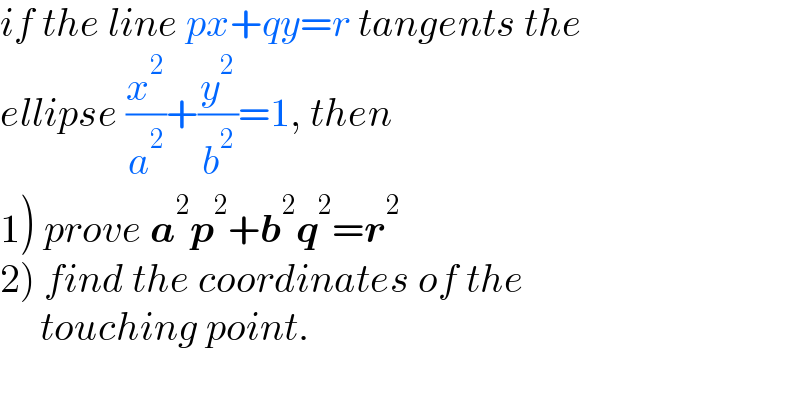Question Number 157926 by mr W last updated on 29/Oct/21

Answered by mindispower last updated on 29/Oct/21

Commented by mr W last updated on 30/Oct/21

Commented by mindispower last updated on 02/Nov/21

Answered by som(math1967) last updated on 30/Oct/21
![px+qy=r ⇒y=((r−px)/q) (x^2 /a^2 ) +(y^2 /b^2 )=1 or. (x^2 /a^2 ) +(((r−px)^2 )/(b^2 q^2 ))=1 or. x^2 b^2 q^2 +a^2 p^2 x^2 −2a^2 pxr+r^2 a^2 =a^2 b^2 q^2 or.(b^2 q^2 +a^2 p^2 )x^2 −2a^2 pxr+a^2 r^2 −a^2 b^2 q^2 =0 ...1) px+qy=r is tangents of (x^2 /a^2 ) +(y^2 /b^2 )=1 ∴ (−2a^2 pr)^2 −4(b^2 q^2 +a^2 p^2 )(a^2 r^2 −a^2 b^2 q^2 )=0 [ for equal roots discriminant is 0] 4a^2 [a^2 p^2 r^2 −(b^2 q^2 +a^2 p^2 )(r^2 −b^2 q^2 )]=0 a^2 p^2 r^2 −b^2 q^2 r^2 +b^4 q^4 −a^2 p^2 r^2 +a^2 b^2 p^2 q^2 =0 b^2 q^2 (b^2 q^2 +a^2 p^2 −r^2 )=0 ∴ a^2 p^2 +b^2 q^2 =r^2 from equn. 1 (b^2 q^2 +a^2 p^2 )x^2 −2a^2 pxr+a^2 r^2 −a^2 b^2 q^2 =0 [(a^2 p^2 +b^2 q^2 =r^2 ] r^2 x^2 −2a^2 pxr+a^2 (r^2 −b^2 q^2 )=0 r^2 x^2 −2.rx.a^2 p+a^4 .p^2 =0 x=((a^2 p)/r) y=((r−px)/q)=((r−((a^2 p^2 )/r))/q)=((r^2 −a^2 p^2 )/(qr)) (((a^2 p)/r),((r^2 −a^2 p^2 )/(qr))) (((a^2 p)/r),((b^2 q)/r))](https://www.tinkutara.com/question/Q157931.png)
Commented by mr W last updated on 30/Oct/21

